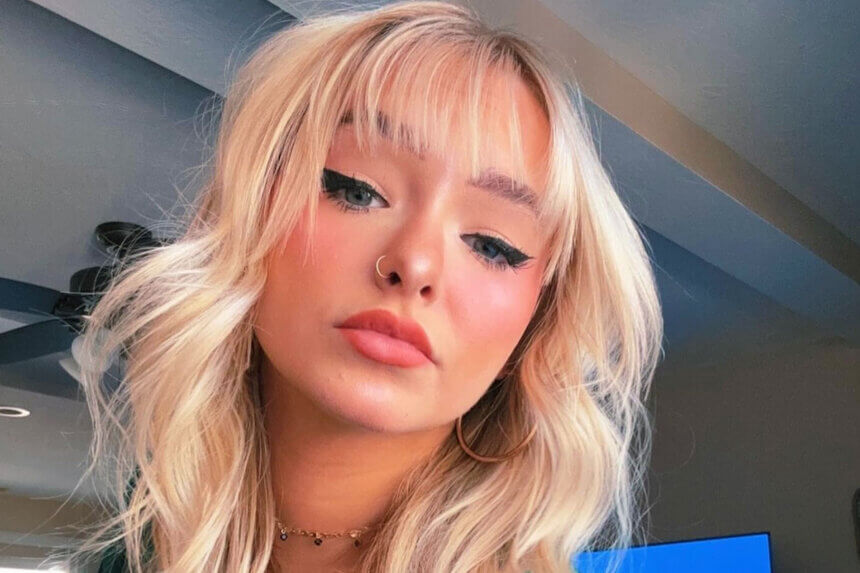Zoe Laverne net worth sits at approximately $1 million as of 2025, though estimates vary between $700,000 and $1.5 million depending on the source. The TikTok star built this wealth accumulation through social media income, brand endorsements, merchandise sales, and music. She ranks 48th among top TikTok influencers with over 21 million followers. Her monthly earnings reportedly range from $50,000 to $60,000 from various revenue streams. Understanding her financial status requires examining how influencer wealth is calculated and what drives her economic position in the competitive creator economy.
How is Zoe Laverne’s Net Worth Estimated?
Celebrity Net Worth reports her estimated worth at $1 million, while other sources cite different figures. Wikibioworth lists it at $700,000. The variation exists because digital creator finances are hard to pin down.
Net Worth Spot estimates she earns close to $20,000 monthly, or about $240,000 annually. These calculations factor in her TikTok engagement, Instagram following, YouTube views, and brand partnerships. Her TikTok account alone, with over 2 billion likes, has an estimated value of $1.19 million. The actual cash she takes home depends on deals, taxes, and business expenses. The term “net” in net worth refers to the value after deductions, while “worth” represents the total monetary value of her total assets.
Different tracking sites use different methods to calculate financial worth. Some look at follower count correlation and multiply by standard rates. Others analyze engagement rates and view counts. Multiple sources report she earns an estimated $1,000 per sponsored post on Instagram. The truth likely sits somewhere in the middle of all these estimates. Her fortune reflects both liquid assets and the calculated value of her online presence.
Influencer earnings fluctuate month to month. A creator might land a big deal one quarter and have nothing the next. This makes exact figures slippery. What we know for sure is that Zoe built substantial income components from her online presence. Unlike traditional celebrities who might face significant debt or liabilities, most successful influencers maintain relatively clean balance sheets with minimal public debt.
Income Sources: Sponsorships, Ads, Merch & More
Zoe’s money comes from multiple channels. TikTok forms the foundation, where she attracts over 21.8 million followers and racks up over 2 billion views. The platform pays creators through its Creator Fund and allows them to collect gifts during live streams. Her TikTok earnings represent the largest single contributor to her overall wealth.
She has worked with fashion brands like Pigeon Pop, reportedly earning around $750 per week for one-minute promotional videos. That adds up to roughly $3,000 per month from just one partnership. Instagram sponsored posts bring in an estimated $1,000 each, helping her earn $50,000 to $60,000 per month. This Instagram income demonstrates the power of cross-platform presence.
Merchandise forms another crucial income stream. She sells clothing like hoodies, tees, and pants on her official website and through digital stores like Bonfire and RedBubble. Fans buy items to show support. While exact sales numbers stay private, merch typically brings in steady revenue for popular creators. This represents an important part of her asset diversification strategy.
YouTube ad revenue adds to the total. She has over 429,000 subscribers on her main YouTube channel. Views translate to ad dollars, though YouTube pays less than sponsorships. She also explored music, with her song “Lost It All” amassing over 1 million streams on Spotify. Streaming pays poorly compared to other sources, but it diversifies her portfolio and adds both monetary value and social value to her brand.
Promoters typically pay $2 to $4 per 1,000 followers for sponsored content. With her massive following, even conservative rates generate significant income. The mix of platforms and monetization methods creates financial stability when one source dips. Multiple sources report she owns assets up to a valuation of $300,000, demonstrating her accumulated wealth beyond just cash flow.
Net Worth Over Time: Trends and Changes
Zoe started her career as a content creator in 2016 when TikTok was still called Musical.ly. She posted makeup tutorials, lip-sync videos, and dance content. Her viral success on Musical.ly allowed her to become a verified creator in 2017, earning over 1.5 billion likes on her videos.
Her wealth grew as platforms merged and her follower count increased. When Musical.ly became TikTok, she translated her massive fan following seamlessly. By 2019, she was pulling in enough to make social media her full-time job. Her relationship with fellow creator Cody Orlove boosted visibility. They toured together and created joint content that expanded both their audiences.
The period from 2017 to 2020 marked steady growth in her financial success. Early estimates placed her fortune at more modest levels. By 2024, that figure had climbed to the current $1 million range. Growth slowed after controversies hit, but her core audience remained loyal. This demonstrates how influencer wealth can show resilience even during reputation challenges.
Recent years brought challenges that affected earnings. Brand deals became harder to secure after negative publicity. Some sponsors cut ties. Despite this, her net worth held relatively stable because she diversified income sources early. She built a buffer that protected her finances when problems arose. Her ability to maintain her economic position despite setbacks shows strategic planning.
Risks and Uncertainties: What Could Change Her Value?
Controversies present the biggest risk to Zoe’s net worth. In November 2020, she apologized for kissing a 13-year-old boy named Connor. The incident sparked massive backlash. In May 2025, Connor posted a video on TikTok accusing her of statutory rape and child grooming, alleging the grooming began in August 2019 when he was 12 years old.
These allegations carry serious weight. Brands distance themselves from creators facing legal issues or public outcry. Lost sponsorships directly reduce income. The public outcry had tangible effects: sponsorships were withdrawn, and her once-booming brand partnerships dwindled. When companies pull out, monthly earnings can drop by tens of thousands of dollars, threatening the stability of her total assets.
Platform changes also create risk to her financial worth. TikTok could adjust its algorithm, reducing her reach overnight. New policies might limit content or change monetization rules. YouTube has demonetized creators for violations. Instagram constantly tweaks how posts appear in feeds. Staying visible requires adapting quickly to maintain her monetary value.
She faced criticism for selling exclusive images of her newborn daughter Emersyn for $15 per image. Critics called this exploitative. Actions like these damage reputation and make brands hesitant to partner. Public trust, once broken, takes years to rebuild. These incidents affect not just her current income components but her long-term earning potential.
Age demographics shift too. Zoe’s audience grows older while TikTok attracts younger users. If she can’t maintain relevance with new teens, her influence wanes. Creators who fail to evolve often see sharp declines in engagement and income within a few years. This represents an ongoing threat to her financial status in the competitive social media landscape.
Comparison with Peers: How Zoe Stacks Up
She is currently ranked 48th on the list of top 50 TikTok influencers. This puts her in the upper tier but not at the peak. Top creators like Charli D’Amelio have 10 times her follower count and proportionally higher earnings. Still, 48th place represents serious success in terms of influencer wealth.
Creators with similar follower counts typically earn in the same range. Those with 20 to 25 million followers often report net worth between $500,000 and $2 million. Zoe’s $1 million estimate fits the pattern. Her earnings align with what comparable influencers make through brand deals and platform payments. This peer comparison helps validate estimates of her fortune.
Her peers diversify income similarly. Many sell merchandise, partner with brands, and maintain multiple social accounts. The difference often comes down to consistency and reputation. Creators without major scandals command higher rates for sponsored content. Clean images attract premium partnerships that boost accumulated wealth faster.
Some comparable stars earn more by expanding into traditional media. Acting roles, reality shows, and music deals boost income beyond social media. Zoe dabbled in music but hasn’t pursued it aggressively. Focusing more on these opportunities could increase her monetary value significantly and improve her overall economic position within the creator space.
Geographic location matters too. Creators in major markets like Los Angeles network more easily and land bigger deals. Zoe’s Indiana roots may limit some opportunities, though remote work has reduced this gap. Her financial worth remains competitive within her segment of the creator economy, demonstrating that location is less critical than engagement rates.
Recent Events That May Impact Her Net Worth
The May 2025 allegations from Connor Joyce represent the most significant recent event. He accused her publicly on TikTok, claiming she threatened self-harm to prevent legal action. Connor stated that law enforcement dismissed his initial reports as a publicity stunt despite evidence. The situation remains unresolved and poses a direct threat to her financial success.
Public perception shifted dramatically after these claims surfaced. Comment sections filled with criticism. As of May 2025, comments on her TikTok have been turned off. This limits engagement but also prevents the spread of negative sentiment on her posts. Brands monitoring social reaction likely noted the controversy and may adjust their willingness to partner, directly affecting her income components.
She married Dawson Day on October 5, 2021, and they have a daughter named Emersyn Raylee Day, born in September 2021. Motherhood changed her content focus. She posts more family material now. This appeals to some audiences but may alienate others who followed her for different reasons. The shift demonstrates how personal life events can influence wealth accumulation patterns.
Platform algorithm changes affect all creators constantly. TikTok rolled out new features and adjusted how content gets distributed. Creators who master new tools gain advantages in maintaining their estimated worth. Those who resist change lose visibility. Zoe’s ability to adapt determines whether her reach grows or shrinks, directly impacting her total assets.
The broader influencer market faces saturation. More creators compete for the same pool of brand partnerships. Companies spread budgets across more people, reducing individual rates. Economic conditions also matter. During recessions, marketing budgets shrink first. Influencers feel this pressure immediately through fewer deals and lower offers that threaten their financial status.
Three key takeaways about Zoe Laverne’s net worth:
1. Her wealth varies by source but centers around $1 million. Different tracking sites use different methods, creating a range from $700,000 to $1.5 million. The true figure likely sits in the middle, with $1 million being the most commonly cited estimate for her financial worth.
2. Multiple income streams provide financial stability. She earns from TikTok creator funds, Instagram sponsorships at $1,000 per post, brand partnerships like Pigeon Pop paying $750 weekly, merchandise sales through multiple platforms, YouTube ad revenue, and music streaming. This diversification of income components protects against single-source failures and supports her accumulated wealth.
3. Controversies directly threaten her earning potential. The May 2025 allegations and previous scandals caused sponsors to withdraw support. Reputation damage in the influencer space translates immediately to lost income, as brands avoid association with controversial figures. This ongoing risk affects both her current monetary value and long-term economic position in the creator economy.








